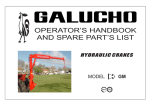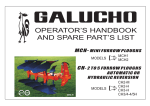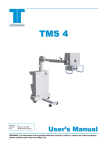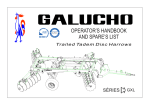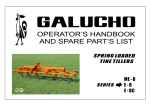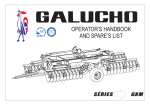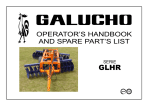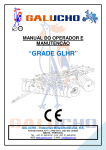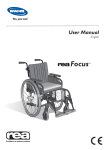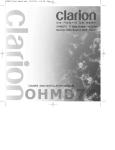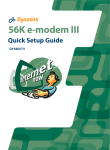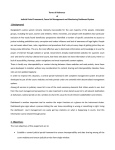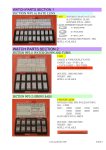Download M. O. N-D UK
Transcript
OPERATOR’S HANDBOOK AND SPARE PART’S LIST DISC PLOUGHS MODELS N2D - 28F N3D - 28F N4D - 28F N5D - 28F INDEX RECOMMENDATIONS TO THE OWNER CONDITIONS OF GUARANTEE INNOVATIONS 1- EXPLANATORY NOTE 2- CONSTITUTION 3- ASSEMBLAGE 4- ATTACHMENT TO THE TRACTOR 5- TECHNICAL SPECIFICATIONS (APPROX.) 6- ADJUSTMENTS 7- WORKING 8- MAINTENANCE 9-REPLACING THE PARTS OF GREATEST WEAR 10- ORDERING SPARE PARTS 11- SECURITY REGULATIONS RECOMMENDATIONS TO THE OWNER CONDITIONS OF GUARANTEE . The decision to opt for GALUCHO was a good one. The result of many years of experience, under the most difficult and diverse working circumstances, GALUCHO material gives complete satisfaction to its many thousands of users, both in Portugal and in over 40 countries, of different continents, where it is already at work. We are sure that, if used properly, and given the necessary care to maintenance, the machine you have just acquired will perform the efficient and economical job for which it was designed, and which a user has the right to expect from it. The present manual contains very important instructions concerning set-up, tuning, maintenance, etc., As well as diagrams and a parts list. Begin by reading it, attentively, in order to familiarise yourself with the material. Then, keep it in secure and accessible place, for future consultation. If you still have doubts, consult the distributor who supplied the machine, or else consult us, as it is in all of our interests that you be satisfied with, and obtain maximum yield from your purchase. Recordings and technical data are indicated by name and subject to alterations without previous notification. . 1- Our company guarantees all the agricultural equipment which is manufactured for a period of two years from the date of invoice. 1.1- This guarantee only includes the supply of replacement parts or components which are proved to be deficiently made or installed, and does not cover the payment of manual labour or displacement costs. 1.2- Any components considered by this company to the worn out, are excluded from the guarantee. 1.3- The guarantee given by this company will not include any parts not made by themselves, for examples tyres, which will remain the exclusive responsibility of their respective manufacturer, and this decision will be communicated to the claimant with all its consequences. GALUCHO - Indústrias Metalomecânicas, S.A. Apartado 4003 - E C S. João das Lampas 2706-851 S. João das Lampas - PORTUGAL Telef.: (351) 21 960 85 00 Fax: (351) 21 960 85 85 www.galucho.pt [email protected] 2- Reasons for immediate loss of guarantee: 2.1- Use of equipment in abnormal working conditions, or used with tractors of different powers than those indicated, in each different case, in our technical literature. 2.2- The substitution of pieces or accessories for others not made or recognised by this company. 2.3- Any repair or alteration done, during the period of guarantee, without our knowledge or authorisation. 3- All claims against the guarantee must be communicated to us by the respective retail agents, by means of a claim form. The pieces or accessories, which are the objects of complaint, must be sent for examination to our Technical Services and Quality Department. If the reasons for the complaint are confirmed and accepted, new pieces will be supplied, or their value credited to the customer, if already sent. 4 - The powers indicated in our catalogues and other literature as necessary for certain equipment of our . construction, may vary according to the different types and states of the earth, the experience of the operator, the state of the tractor, and the adherence of the latter to the terrain on which it is working. 5 - This company can only accept the return of equipment to the factory, within a maximum of 15 days after the sending of the invoice, providing it has not been used in a working situation, it is not a model already withdrawn from production, or if it is still part of our production range, there have been no alterations made to the model. 6 - In compliance with regulations determined in the Directiva Máquinas/CE (Machines Directive/CE), this company: 6.1 - Manufactures its machines respecting the relevant safety regulations, namely with respect to the protection of moving parts; 6.2 - Supplies a certificate of conformity, referring to the norms and regulations fulfilled; 6.3 - Supplies a user's manual and catalogue of parts for each machine. NOTE: Every Galucho dealer is obliged to supply the eventual consumer with: - The safety devices, fixed or detachable, relevant to each machine; - The certificate of conformity and the user's manual with a catalogue of parts for each machine. 7 - We recommend the reading of our pamphlet: “General Conditions of Sale and Payment”. 8 - For any necessary clarifications, please consult our Commercial Services. INNOVATIONS GALUCHO-IND. METALOMECÂNICAS, S.A. continually attempts to perfect its products, reserving itself the right, at any time, to make alterations to the design and/or to the specifications of construction materials, and its respective components, without incurring, as a result, the obligation to apply these alterations to machines previously made and sold. 1- EXPLANATORY NOTE Although all the models of the three series are dimensionally different, the assembly, adjustment, maintenance, etc. details are the same. The structural differences may be checked in the table of specifications. Flange hub shields - pressed reversible parts to protect the hubs against wear. Scrapers - of highly resistant pressed steel, the scrapers are independent and adjustable for each disc. Furrow wheel or stabilizer - maintains the stability of the machine whilst it is ploughing. There are various settings and the axle is supported by adjustable taper roller bearings protected by retainers. Standing leg - leg fixed to the chassis to maintain the plough up right when it is not attached to the tractor, so that it remains in the correct position ready to be attached to the tractor. N3D-28F 2- CONSTITUTION Frame or Chassis - this is a welded tubular framework of forged steel which supports all other parts of the disk plough. Prop - the steel prop mechanism consists of two arms which support its, to which is attached the upper hydraulic arm on the tractor. The offset bar is attached underneath the prop which in turn permits various different setting, the attachment for type I, II or III, depending upon the model and what is to be attached to the 2 lower hydraulic arms of the tractor. Sets of discs - These consist of a disc assembly carrier which links the frame, and turn the hub, disc holder plate, disc and flange hub shield. The hubs and disc holder plates made from pressed steel, and have taper roller, sealing washer and a leak elimination system. N2D-28F N4D-28F 4- ATTACHMENT TO THE TRACTOR N5D-28F A- Frame; B- 3.rd point bar; C- Cross shaft; D- Scrapers; E- Depth control wheel; F- Stay; G- Link pins 3- ASSEMBLY If, for space reasons, the ploughs are delivered dismantled, the following procedure must be followed to assemble them. - Assemble the prop mechanism with the respective screw and linkage pins. - Attach each disc unit to the frame using the respective screw in central hole of disc assembly carrier and a screw clamp. - Tighten the 4 screws that connect the furrow wheel to the support of the last disc. The lateral adjustment brace should be introduced and fixed. - Position the standing leg in its respective support and secure it with a tension pin. After assembling the plough and verify that everything has been carried out correctly, connect it to the hydraulic lifting equipment of the tractor in the same way as any other agricultural implement, paying attention to the following prop settings. - The different methods of connecting the linkage bar to the system in order to obtain a more efficient automatic depth control. - The two different height settings of linkage and tension pins for a better performance, dependent upon the make of tractor used. - 6 or 8 holes depending upon the model, for the lateral movement to the left or to the right of the prop, giving 3 or 4 different settings in line with the adjustment necessary to the gouge of the tractor, so that the wall of the furrow opened by the first disc is in line with the inside of the rear tyre. - 4 holes which allow the chassis to be inclined in relation to the furrow wheel, and which offer a permutation of cutting angle position. After connecting the plough to the tractor the standing leg should be removed and place in the inverse position. Carry out a lifting exercise to make sure everything is as it should be. Do not forget to connect the stabilizers, always leaving a minimum space to allow the plough total freedom. 5 - TECHNICAL SPECIFICATIONS (APPROX.) DISCS MODELS QUANT. WORKING Ø DEPTH ( " - mm) (m) WORKING UNDERBEAM WIDTH CLEARANCE (m) (m) DISTANCE BETWEEN BODIES (m) WEIGHT (kg) REQUIRED POWER (hp) N2D - 28F 2 28 - 710 0,35 0,65 0,69 0,58 365 35 - 55 N3D - 28F 3 28 - 710 0,35 0,95 0,69 0,58 475 55 - 70 N4D - 28F 4 28 - 710 0,35 1,25 0,69 0,58 595 70 - 90 N5D - 28F 5 28 - 710 0,35 1,55 0,69 0,58 715 90 - 110 6.1- Horizontal -The machine is kept transversely horizontal trough the third point assembly by maintaining the two lower hydraulic tractor arms the same length. Lengthening or shortening the tractor linkage regulates the longitudinal horizontal state of the plough. These two settings are considered to be correct when, working on level ground, the plough is level with the ground when seen from the side or from behind. It should be remembered that the longitudinal setting must always be done by furrow wheel. Fig. 2 A - Disc; B - Disc carrier; C - Flange hub; D - End cap; E - Articulation screw; F - Selection; G - Angle of penetration hole; H - Disc arm; I - Three hole scale for angle; of tilt regulation; J - Flange hub shield 6.2- Ploughing depth - This is decided by the angles of the discs with the ground, whether vertically related penetration angle or whether related to the direction of movement - cutting angle. Increasing the penetration angle will help to turn the ground over better. This reduces the penetration power of the discs and also makes it necessary to have a more potent tractor. The larger the cutting angle the deeper the ploughing, with traction increasing in the same proportion. 6.2.1- Setting the penetration angle - This must be done separately for each disc, with the same setting applied to each one. Loosen the link screw and move the selection screw to the next higher hole if you wish to lessen the angle. Make sure the 2 screws are tightened after making any changes. Fig. 3 A - Disc; B - Scraper; C - Scraper arm; D - Scraper support; E - Scraper regulator; F - Fixing screws. 6- ADJUSTMENTS Other than prop settings described in point 4, further settings can be obtained in the following way: 6.2.2- Setting the cutting angle - Each disc assembly carrier has three holes which allows various individual settings. As the offset bar also permits 4 different groups of settings, this gives a total of 12 different settings. The individual setting of each disc should be carried out separately so that they are equal. After loosening the nuts of each clamp, take out the screw. Rotating the assembly carrier, utilize one of the other two holes, depending upon desired angle. The group setting is done by altering the fixed position of the frame in relation to the offset bar and is obtained by changing the fixed position of 2 screws of the 4 existing holes. Any alteration to the cutting angle automatically means the altering the furrow wheel steel. 6.3- Width of cut - Altering the angle of the plough chassis in relation to the offset bar (There are 4 different positions) gives the same number of different cutting depths. This is the cutting angle variation described in point 6.2.2. The maximum cutting depth is equal to the minimum cutting angle and vice-versa. Special attention must be paid to ensure that the depth of the open furrow out by the front disc is always equal to the others. 6.3.1- Clearance between discs - It is natural that the discs became reduced in diameter though normal wear and tear- resulting in a strip of ground left unploughed between furrows. This can be avoided by making the disc setting closer together as they become worn. This process reduces the depth of cut but improves the quality of the ploughing. Slacken the screw clamp nuts of second and consecutive discs. Loosen and remove the cutting angle selection screw and advance the disc one hole. When the holes are equal replace and tighten the Fig. 4 A- 3.rd point bars; B- Prop; C- Adjusting holes; D- Holes for a angle of tilt regulation 6.4- Furrow wheel or stabilizer - The furrow wheel plays a fundamental part in the stability of the plough in action, guiding the plough in such a way that it does not move away from furrow. This facility is caused by the force produced by t5he obliqueness of the work of the discs in relation to the tractor. The height setting is relative to the chassis and also the inclination of ground to be ploughed. The height must vary according to the depth of cut required, already explained in the cutting angle and penetration angle setting. Turn the handle to higher or lower the wheel as desired. Maintaining the correct heights through wear of the furrow wheel or discs is obtained by altering the fixed setting in one of the three holes in yoke. The setting for the lateral movement of the wheel, enabling it to work at the bottom of the furrow next to the wall, is obtained by increasing or decreasing the length of the penetration angle setting bar, rotating it in the respective nut.The furrow wheel is set correctly when there is no noticeable reaction in the direction of the tractor working on level ground. 6.5- Scrapers - These are independent for each disc and are responsible for removing the earth from the discs and permitting the turning over the soil an thus covering the vegetation more efficiently. Height settings and distances from discs can be regulated very simply by slackening the 2 holding screws, choosing the desired position and tightening the nuts. It may necessary to take the scrapers off it they become choked up because of the state of the land or vegetation. 7- WORKING 7.1- AVERAGE WORKING PERFORMANCE Although work performance may vary due to a number of factors, it is useful to state the process for determining it. It is necessary to know: Ws - Average speed of working, in km/h; Ww - Working width (m) Fe - Field efficiency. This is a corrective factor which varies for each type of work, and which is a consequence of different determining factors, such as: type and state of the soil being worked; configuration and size of the land; efficiency and effort of the operator, etc. Without too much risk of error, we can assume an average factor of . Ec=0,8. Example: What is the average working performance of a plough with a cutting depth of 1.55 m, working at an average speed of 6 km/h? Aw = WsxWwxFe Aw= 6x1,55x0,8 = 0,74 ha/h 10 10 8- MAINTENANCE To maintain any implement in perfect working condition, and to guarantee that it has a long and profitable working life, avoiding the loss or premature wearing of its components, it is essential that some care and maintenance be invested in it, over the following periods: 8.1- Before the start of each day Make a thorough check of the plough, paying particular attention to the following points: - Ensure that all nuts and screws are tightened; - Make certain that all moving parts - discs, flange hub shields, scrapers and furrow wheel are in good working order, - Check the disc hubs for leaks. 8.2 - During Work In case of new plough tighten all nuts at the end of the first day. - Lubricate the plough after every 8 hours of work - With Grease 2, or equivalent - all the grease nipples of the various articulations - With oil, the remaining mobile points; 8.3- In case of prolonged stop - Carefully wash the plough with pressurized water and shelter it from sun and rain. - Carry out an overhaul, retighten and replacing whatever is necessary. - Start the hydraulic cylinders so that the pistons are brought in; - Perform any necessary painting retouches, do a general lubrication. Following the previous procedures will assure the ploughs, perfect work conditions for the next campaign. Remarks: - Always clean the grease nipples, before and after lubrication; - Pump as many times as necessary until clean greases come out. 8.4- Elimination of play in the roller bearings Play can occur in the roller bearings of the discs or the furrow wheel. Take the following steps to avoid these situations: - Disc hub - Take off the hub cap, loosening the 3 securing screws, - Remove the split cotter pin from the slotted nut and rotate it until the slack disappears ,allowing the disc to turn freely; - Replace the split cotter pin in the slotted nut and return the hub cap, - Furrow wheel - Remove the hub cap and proceed as for the discs. A - Angle of tilt regulator screw; B - Hole for screw insertion; C - Clamp Fig. 6 A- Adjustment brace; B- Support of last disc; C- Handle; D- Yoke; E- Bar regulation 9- REPLACING THE PARTS OF GREATEST WEAR The parts, which received the most wear, are the discs, flange hub shields and scrapers. Their respective duration obviously depends upon the type of the soil they are used to plough, the conditions of utilization and amount of maintenance out. The following steps should be taken to replace the parts previously mentioned. 2- Outline the quantities, codes, and designation of the parts, as indicated by the catalogue of parts. 9.2- Flange hub shields As these are reversible they should be turned round once one side is worn. This is done by removing the 2 fixing screws. They should be replaced before they become completely worn out. It should be remembered that the lack of opportune reversal or replacement of these flange hub shields could mean the necessary substitution of the hubs which is a very much more expensive exercise. 4- To facilitate the completion of orders, all demands must be made separate from other correspondence, and indicate the destination and the transport to be used. In case the client has no current account with our company, he should enclose with his order, the amount that corresponds to the cost of his demand. If the demand omits a preference, in terms of means of transport, we will use that which we feel to be most advantageous. 9.3- Scrapers When there is no more room for adjustment due to wear, they can be removed by simply out the fixing screws. 5- The parts can be picked up from our warehouses, in S. João das Lampas, or placed by us in the railway or any other station, in Sintra or Lisbon. 10- ORDERING SPARE PARTS 6- The return of parts or equipment whose parts have stopped being made, or which are still part of our production line but have been altered, will not be accepted. We advise you, as farmers, that replacing worn out parts at the right moment will avoid abnormal mobilization of the machine (with the consequent loss of money and time), and will cheapen the units of work produced, and prolong its useful, economical life-span. It is always better to use genuine GALUCHO parts, because: - They are perfectly interchangeable; - They guarantee correct adaptation and functioning. While they could, in some cases, be a little more expensive in terms of initial cost, they always end up more economical than any other. To simplify and speed up the supply of spare parts, it is recommended, in the consumer's own interests, that this procedure is followed: 1- Indicate the model, series, and number written on the identification plate, which each machine has 3- To avoid errors, written confirmation of orders eventually transmitted by telephone is indispensable. The identification plates GALUCHO indicate the following specifications, which will be useful when ordering spare parts. - INDÚSTRIAS METALOMECÂNICAS, S. A. DOC Nº 08.4 (MQ) Fig. 5 9.1- Discs With the plough slightly suspended on 3 hydraulic points of the tractor, loosen the 4 screws, which hold each disc in place. Remove the old disc and replace it with a new one with the same specifications. (Fundada por JOSÉ FRANCISCO JUSTINO) FÁBRICA DE ALFAIA S AGRÍCOLA S REBOQUES, CARROÇARIA S E BA SCULANTES PARA CAMIÕES Ano Fabr. APARTADO 4003 - EC S. JOÃO DASLAMPAS 2706-851 S. JOÃO DASLAMPAS - PORTUGAL Mod. 1 1-MODEL Série Peso (Kg) 2 2-SERIES Nº 3 3-NUMBER 11- SECURITY REGULATIONS . Working with tractors and agricultural machines requires that the operator knows what he is doing and that much care is taken. He must be conscious and cautious of the dangers which imprudence can cause, not just to the agricultural enterprises which they run. In an attempt to avoid accidents, therefore, we advise the following security rules: 1 - In attaching any implement to the tractor, use only the place which the respective manufacturer advised for the operation, verifying is carried out in order. . 2 - Whenever, for reasons of repair, checks, set-up or otherwise, you need to get under the implement, never do so without the relevant props. 3 - In activating the hydraulic system of the tractor, first check that the implement, trailer, frontal load, or otherwise, in movement, can not reach anyone. 4 - Never authorise the transport of passengers on the implement, whether during work time or on the road, equally not behind ploughs, or grass cutters, as during their work, as stones, sticks etc. could fly up out of the machines. 5 - The implement should never be detached while in movement. If it has to be done, immobilizes it well and stop the motor. 6 - Always use protective guards on transmissions linked to the power sockets of the tractor. 7 - Use counterweights on the front or on the front wheels, as, with implements mounted, the steering . very light and it will have a of the tractor will be tendency to uplift. Double check the maintenance during a job, manoeuvres or on the road. It could also be necessary to mount a rear weight to the tractor when operating with a frontal load and the load being carried is particularly heavy. 8 - Do not forget that the dangers increase with the incline of the terrain on which it is working or being moved. Exercise maximum caution, paying attention to accentuated inclinations, especially lateral ones, which should be avoided. 9- When you work with trailers, you should never forget to: - Check your brakes; - Attach the emergency brake device to the tractor; - Plug in the electric installations; Also remember that: - The trailer must always brake before the tractor; - All load, especially high load, must be well fastened down; - The two pins to fix down the box must be in the right places, depending on the side which you need to balance; - The balancing must be light, and without jolts; - You may only transport persons when legally authorised to do so, when they are seated, and with all the coverings closed. 10 - Whenever in transit on a public highway remember that: - On leaving an agricultural property,. or a private road, you never have priority of entry into a public road. All other road users, coming from the left or right, have priority over you; - You must respect the highway code and all signs and light signals; - The stabiliser switch for the two brake pedals must be on; - The stabilisers or the chains must be tight so that there can be on lateral oscillation of the mounted implements, which must only be lifted to the height necessary to avoid contact with the ground (about 0,30 cm) or, if the tractor has a hydraulic blockage, until this switches on; - Speed of travel must be reduced whenever the state or the relief of the road requires it; If you take this advice which we give here, we hope that you will neither have, or cause any accidents. This is what GALUCHO wishes for, and expects from their clients. INSUFFICIENT DEPTH EXAGGERATED DEPTH IN REAR FURROW INSUFFICIENT WIGTH IN FRONT FURROW REACTION IN THE TRACTOR DIRECTION EXCESSIVE DEPTH X EXAGGERATED DEPTH IN FRONT FURROW X EXAGGERATED WIGTH IN FRONT FURROW X X TRACTOR SKATING X X X TRACTOR RAISE X X X X ADJUST THE TUNNING NUT ADJUSTE THE TRACTOR DEPTH CONTROL X X ADJUST THE REVERSION CHAIN LENTH X REGULATE THE SCRAPPERS X X X REGULATE THE DISCS SHARP THE POINT BAR X ADJUSTE THE TRACTOR GAGE PUT WEIGHTS IN THE TRACTOR FRONT REDUCE THE VELOCITY BALAST THE MOTRICE WHEELS BLOCK THE DIFFERENTIAL USE THE TRACTION CONTROL GO DOWN THE 3 HYDRAULIC POINTS ARAISE THE 3 HYDRAULIC POINTS LOWER TRANSVERSE BAR DECREASE THE ATACK ANGLE INCREASE THE ATACK ANGLE SHORTEN THE SUPERIOR HYDRAULIC ARM X X SKATING AVANCE THE POINT BAR X X DIFICULTIES IN REVERSION X X PROBLEMS EXTEND THE SUPERIOR HYDRAULIC ARM RECOMMENDATIONS PRATICAL ADJUSTEMENTS ADVICES / 01 / 04 Data 99 / 01 / 04 Data Designa. / / FIXED DISC PLOUGS Serie N2D-28F Cod. 215140000 FU Alter. Verif. ADA EM 1 9 ND 20 Desen. Data 99 SARA INDÚSTRIAS METALOMECÂNICAS, S.A. S. JOÃO DAS LAMPAS - PORTUGAL 99 / 01 / 04 Data 99 / 01 / 04 Data / / FIXED DISC PLOUGS Serie N3D-28F Cod. 215220000 FU Designa. ADA EM 1 9 ND 20 Data Alter. Verif. Desen. SARA INDÚSTRIAS METALOMECÂNICAS, S.A. S. JOÃO DAS LAMPAS - PORTUGAL 99 / 01 / 04 Data 99 / 01 / 04 Data / / FIXED DISC PLOUGS Serie N4D-28F Cod. 215320000 FU Designa. ADA EM 1 9 ND 20 Data Alter. Verif. Desen. SARA INDÚSTRIAS METALOMECÂNICAS, S.A. S. JOÃO DAS LAMPAS - PORTUGAL / 01 / 04 Data 99 / 01 / 04 Data / / FIXED DISC PLOUGS Serie N5D-28F Cod. 215420000 FU Designa. ADA EM 1 9 ND 20 Data 99 Alter. Verif. Desen. SARA INDÚSTRIAS METALOMECÂNICAS, S.A. S. JOÃO DAS LAMPAS - PORTUGAL NOTES NOTES - INDÚSTRIAS METALOMECÂNICAS, S. A. (Fundada por JOSÉ FRANCISCO JUSTINO) APARTADO 4003 - EC S. JOÃO DAS LAMPAS 2706-851 S. JOÃO DAS LAMPAS - PORTUGAL TELEF.:(351) 21 960 85 00 FAX: (351) 21 960 85 85 www.galucho.pt [email protected] 0608.N-DF.3




















